Books by Faculty
 German-Jewish Popular Culture before the Holocaust: Kafka's Kitsch
German-Jewish Popular Culture before the Holocaust: Kafka's Kitsch
By Dr. David Brenner
David A. Brenner examines how Jews in Central Europe developed one of the first "ethnic" or "minority" cultures in modernity. Not exclusively "German" or "Jewish," the experiences of German-speaking Jewry in the decades prior to the Third Reich and the Holocaust were also negotiated in encounters with popular culture, particularly the novel, the drama and mass media.
Based on research in German, Israeli and American archives, German-Jewish Popular Culture before the Holocaust addresses many of the genres in which a specifically German-Jewish identity was performed, from the Yiddish theatre and Zionist humour all the way to sensationalist memoirs and Kafka’s own kitsch. This middle-class ethnic identity encompassed and went beyond religious confession and identity politics. In focusing principally on German-Jewish popular culture, this groundbreaking book introduces the beginnings of "ethnicity" as we know it and live it today.
Andrey Bely’s “Petersburg”: A Centennial Celebration
Edited by Olga Cooke
Celebrating the one-hundredth anniversary of Andrey Bely’s Petersburg, this volume offers a selection of essays that address the most pertinent aspects of the 1916 masterpiece. The plot is relatively a simple one: Nikolai Apollonovich is ordered by a group of terrorists to assassinate his father, the prominent senator Apollon Apollonovich Ableukhov. Nevertheless, Bely’s polyphonic, experimental prose invokes such diverse themes as Greek mythology, the apocalypse, family dynamics, psychology, Russian history, theosophy, revolution, and European literary influences. Considered by Vladimir Nabokov to be one of the twentieth century’s four greatest masterpieces, Petersburg is the first novel in which the city is the hero. Frequently compared to James Joyce’s Ulysses, no other work did more to help launch modernism in turn-of-the-century Russia.
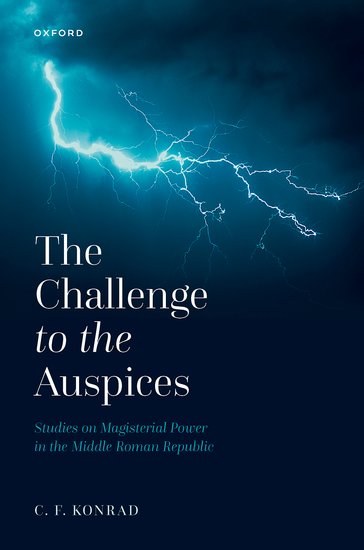 The Challenge to the Auspices
The Challenge to the Auspices
Studies on Magisterial Power in the Middle Roman Republic
By C.F. Konrad
No public action of the Roman state, the populus Romanus, at home or at war, was to be carried out without prior permission from Iuppiter Optimus Maximus. Permission was obtained, in a procedure known as auspices, by the magistrate in charge of the intended action-usually a Consul, Praetor, or Dictator. Auspices thus occupy a fundamental place in the-unwritten-constitution of the Roman State. Yet especially in the 3rd century BCE, acceptance of the principle was not always universal.
The Challenge to the Auspices presents an investigation into the interaction of Roman magistrates during the Middle Republic with the practice of auspices, with a focus on attempts to avoid, ignore, or resist this requirement. Proceeding from an examination of the Roman concepts of imperium and auspices (auspicia), especially as they relate to the realm of war, and of the constitutional position and powers of the Dictator and the Master-of-Horse (magister equitum) relative to each other and to the Consuls and lower magistrates, the work offers six case studies in which Roman commanders questioned, violated, or openly rejected the need for auspices. It is argued that these instances reflect a not insignificant minority view within the Roman ruling class regarding the efficacy of auspices and the necessity of observing them. The catastrophic outcome in several of these events, particularly during the early years of the Second Punic War, rendered further resistance to the practice politically unsustainable, and by the second century resulted in its universal acceptance, regardless of personal belief.
 Confronting crisis in the Carolingian empire: Paschasius Radbertus' funeral oration for Wala of Corbie
Confronting crisis in the Carolingian empire: Paschasius Radbertus' funeral oration for Wala of Corbie
By Drs. Mayke de Jong and Justin Lake
This book provides an accessible new translation of, and commentary on, an important but enigmatic ninth-century text: the Epitaphium Arsenii ('Epitaph of Arsenius') by the monk and scholar Paschasius Radbertus of Corbie. Couched in the form of a literary dialogue between monks grieving for their lost abbot, the Epitaph serves as a major source for the life and career of Wala (here referred to by the nickname 'Arsenius'), a cousin of Charlemagne who became involved in the rebellions against Charlemagne's son and successor Louis the Pious in the 830's.
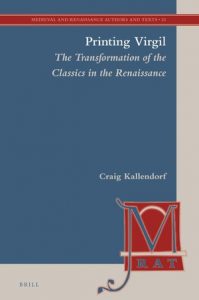 Printing Virgil:The Transformation of the Classics in the Renaissance
Printing Virgil:The Transformation of the Classics in the Renaissance
By Dr. Craig Kallendorf
In this work Craig Kallendorf argues that the printing press played a crucial, and previously unrecognized, role in the reception of the Roman poet Virgil in the Renaissance. Using a new methodology developed at the Humboldt University in Berlin, Printing Virgil shows that the press established which commentaries were disseminated, provided signals for how the Virgilian translations were to be interpreted, shaped the discussion about the authenticity of the minor poems attributed to Virgil, and inserted this material into larger censorship concerns. The editions that were printed during this period transformed Virgil into a poet who could fit into Renaissance culture, but they also determined which aspects of his work could become visible at that time.
 La literatura africana en castellano de los antiguos territorios españoles del Sahara Occidental y de Marruecos
La literatura africana en castellano de los antiguos territorios españoles del Sahara Occidental y de Marruecos
By Alain Lawo-Sukam
Although Spanish is one of the official languages in Western Sahara, Sahrawi and Moroccan literature in Spanish has been little known. With this book, Alain Lawo-Sukam opens a new window to the African-Hispanic literary world, thus expanding knowledge of Spanish-speaking literature in Africa. The persistence of Spanish in the Sahrawi communities not only responds to the colonial heritage, but also to the desire to promote a heterogeneous identity - that of the only Arab country that "speaks, thinks and dreams, and feels in Spanish" - and, therefore , to find in the language a way to distance themselves from Francophonization and resist the occupiers of their territory, that of the Sahrawi Arab Democratic Republic, the only colonized African state today.
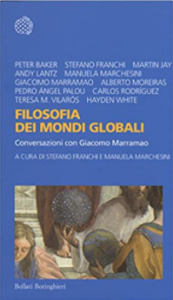 Filosofia dei mondi globali
Filosofia dei mondi globali
Conversations with Italian philosopher Giacomo Marramao.
Edited by Drs. Manuela Marchesini and Stefano Franchi
Filosofia dei mondi globali offers a series of discussions with Italian philosopher Giacomo Marramao about the interaction between the global and the local dimensions of contemporary life and thought, which he describes with the neologism glocalism. Contributions by an international panel of experts ranging from political philosophy, literary criticism, and the social sciences discuss the relevance of political conflict, the politics of translation, the integration of communicative reason with narrative theory, and other topics relevant to the contemporary political debate in dialogue with Marramao's provocative suggestions.
 La galleria interiore dell'Ingegnere
La galleria interiore dell'Ingegnere
By Manuela Marchesini
That Awful mess of Via Merulana (1957) by Carlo Emilio Gadda is a classic novel of Italian modernist literature. A whodunit set in Rome, it takes place during the spring of 1927, at the peak of the Fascist dictatorship. Gadda’s novel responds to historical, epic, and liturgical events whose dates provide the novel’s temporal framework: Mussolini’s launching of the regime’s demographic campaign with the Ascension Day speech (May 1927), the spring equinox that marks the beginning of Dante’s journey in the Divine Comedy (21 March), and the Catholic Annunciation of Mary (25 March).
This study’s contrapuntal reading recovers and interlaces the queer, epic, visual, and religious dimensions to Gadda’s masterwork, repositioning it as a mordantly comic interrogation of political, religious, and artistic ideologies. What emerges is a far-reaching critique whose implications stretch well beyond the confines of Italian fascist discourse and high modernism to impact contemporary debates about gender, politics, and aesthetics.
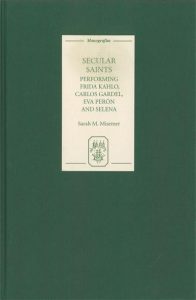
Secular Saints Performing Frida Kahlo, Carlos Gardel, Eva Perón, and Selena - Colección Támesis. Serie A, Monografías
By Sarah M. Misemer
Contemporary icons are drawn from popular culture - musicians, artists, actors, and other personalities we hear on radio or see on television, on screen, in print and in cyberspace. Today's 'gods' are media personalities, and cults surround stars and artists like Frida Kahlo, Carlos Gardel, Eva Perón, and Selena. Because of transnational and global trends in importing and exporting cultural products, the paintings, music, and politics that these figures crafted accrue symbolic meaning in multiple formats. By viewing them through the lens of performance art we can begin to see how their polyvalent personas were first molded and perfected for the public through paintings, tangos, politics, and Tejano music. Once they fashioned their own complex images, these multi-layered icons continued to travel after death over international boundaries, gendered divisions, political borders, and language barriers. Their reincarnation on stage has allowed dramatists to affix and generate new associations, thus converting them into secular saints for contemporary audiences.

Moving Forward, Looking Back
Trains, Literature and the Arts in the River Plate
By Sarah M. Misemer
Moving Forward, Looking Back: Trains, Literature, and the Arts in the River Plate by Sarah M. Misemer argues that the train is paradoxically an anachronistic and modern indicator of River Plate national identity when seen in the literature and film of the region. The train's connections with new concepts of time and space, as well as the rise of the industrial age, make it a symbol loaded with cultural meanings. This project traces the importance of the train as a marker of key moments in Argentine and Uruguayan history from 1854 to the present (nation-building, neo-colonialism, modernization/industrialization, dictatorship, privatization, and debt crisis). Through textual, filmic, and historical accounts this study demonstrates that the train is not simply an icon of the nineteenth-century's Naturalist movement, but rather a powerful contemporary metaphor for authors and directors of the River Plate as they communicate/create collective memory and cultural values in a region mired in uneven spurts of modernization and progress.

The Trial That Never Ends: Hannah Arendt's 'Eichmann in Jerusalem' in Retrospect
Edited by Richard J. Golsan and Sarah Misemer
The fiftieth anniversary of the Adolf Eichmann trial may have come and gone but in many countries around the world there is a renewed focus on the trial, Eichmann himself, and the nature of his crimes. This increased attention also stimulates scrutiny of Hannah Arendt’s influential and controversial work, Eichmann in Jerusalem.
The contributors gathered together by Richard J. Golsan and Sarah M. Misemer in The Trial That Never Ends assess the contested legacy of Hannah Arendt’s famous book and the issues she raised: the "banality of evil", the possibility of justice in the aftermath of monstrous crimes, the right of Israel to kidnap and judge Eichmann, and the agency and role of victims. The contributors also interrogate Arendt’s own ambivalent attitudes towards race and critically interpret the nature of the crimes Eichmann committed in light of newly discovered Nazi documents. The Trial That Never Ends responds to new scholarship by Deborah Lipstadt, Bettina Stangneth, and Shoshana Felman and offers rich new ground for historical, legal, philosophical, and psychological speculation.
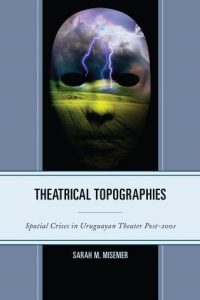
Theatrical Topographies
Spatial Crises in Uruguayan Theater Post-2001
By Sarah M. Misemer
The economic crisis in Argentina in 2001-2002 that spilled over into Uruguay causing fiscal and political problems is the starting point for my research on space and theater, and it demonstrates why we must look at the River Plate in both global and local ways. Connections among monetary policies, industries, and legal, social, and political movements mean that national spaces like Uruguay’s are fraught with tensions that come from both within and outside of borders. Recent economic crises like the one that is occurring in Greece, further demonstrate how nation states and trade blocks must constantly negotiate power as they toggle between national and international pressures. Nation states are being prompted to reconceive perspectives on governance that fall away from the parameters of Westphalian autonomy and reconcile their views with trends that instead require thinking about power as a network with shifting centers.
The introduction launches the study by addressing these political and economic trends, the spatial turn in theater and performance studies, the rise of multiculturalism, and also examines the Uruguayan historical context of the post-dictatorship and impunity laws that pit national sovereignty against international human rights laws. These crises are enacted on the Uruguayan stage and contextualized through networks and spatial topographies, intertextualties on the page, explorations of history and memory, and ultimately notions of identity in four areas: the postdramatic and economic realm (chapter one: Peveroni), cultural geography and pyschogeography (chapter two: Morena), midrash and questions of human rights and growing fascist trends (chapter three: Sanguinetti), and finally in mapmaking on the stage through mise-en-perf/performise and “wayfinding” through sites of contested power (chapter four: Calderón). The concluding chapter (Blanco) looks at the reinterpretation of Greek tragedy as a commentary on the messy process of democratization. Here, access to the polis and power are problematized through the lens of international sex trafficking and gendered roles that exclude portions of the populace from participation in the process of self-governance
 Uncanny Rest
Uncanny Rest
For Antiphilosophy
By Alberto Moreiras
In Uncanny Rest Alberto Moreiras offers a meditation on intellectual life under the suspension of time and conditions of isolation. Focusing on his personal day-to-day experiences of the “shelter-in-place” period during the first months of the coronavirus pandemic, Moreiras engages with the limits and possibilities of critical thought in the realm of the infrapolitical—the conditions of existence that exceed average understandings of politics and philosophy. In each dated entry he works through the process of formulating a life’s worth of thought and writing while attempting to locate the nature of thought once the coordinates of everyday life have changed. Offering nothing less than a phenomenology of thinking, Moreiras shows how thought happens in and out of a life, at a certain crossroads where memories collide, where conversations with interlocutors both living and dead evolve and thinking during a suspended state becomes provisional and uncertain.
 Compound Words in Spanish
Compound Words in Spanish
Theory and History
By María Irene Moyna
This is the first book devoted entirely to the history of compound words in Spanish. Based on data obtained from Spanish dictionaries and databases of the past thousand years, it documents the evolution of the major compounding patterns of the language. It analyzes the structural, semantic, and orthographic features of each compound type, and also provides a description of its Latin antecedents, early attestations, and relative frequency and productivity over the centuries. The combination of qualitative and quantitative data shows that although most compound types have survived, they have undergone changes in word order and relative frequency. Moreover, the book shows that the evolution of compounding in Spanish may be accounted for by processes of language acquisition in children. This book, which includes all the data in chronological and alphabetical order, will be a valuable resource for morphologists, Romance linguists, and historical linguists more generally.
 Forms of Address in the Spanish of the Americas
Forms of Address in the Spanish of the Americas
Edited by María Irene Moyna and Susana Rivera-Mills
In the growing field of address research, Spanish emerges as one of the most complex Indo European languages. Firstly, it presents second person variation in its nominal, pronominal, and verbal systems. Moreover, several Spanish varieties have more than two address variants, which compete and mix in intricate ways. Forms of Address in the Spanish of the Americas showcases current research into this unique linguistic situation, by presenting the original research of twelve scholars from a variety of theoretical and methodological perspectives. The articles cover diachronic change and regional variation, pragmatics, dialect contact, attitudes, and identity. The contributions are contextualized through an introduction and the responses of three established experts, while a conclusion delineates a research agenda for the future. This collection in English is meant to reach scholars beyond the confines of Hispanic linguistics. It should be of interest to Romance linguists and specialists on second person variation across languages.
 It’s not all about you
It’s not all about you
New perspectives on address research
Edited by Bettina Kluge and María Irene Moyna
The twenty-first century has seen a surge in cross-linguistic research on forms of address from increasingly diverse and complementary perspectives. The present edited collection is the inaugural volume of Topics in Address Research, a series that aims to reflect that growing interest. The volume includes an overview, followed by seventeen chapters organized in five sections covering new methodological and theoretical approaches, variation and change, address in digital and audiovisual media, nominal address, and self- and third-person reference. This collection includes work on Cameroonian French, Czech, Dutch, English (from the US, UK, Australia, and Canada), Finnish, Italian, Mongolian, Palenquero Creole, Portuguese, Slovak, and Spanish (in its Peninsular and American varieties). By presenting the work in English, the book offers a bridge among researchers in different language families. It will be of interest to pragmatists, sociolinguists, typologists, and anyone focused on the emergence and evolution of this central aspect of verbal communication.
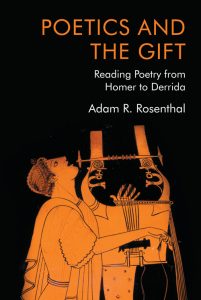 Poetics and the Gift: Reading Poetry from Homer to Derrida
Poetics and the Gift: Reading Poetry from Homer to Derrida
By Adam Rosenthal
Using a broad, comparative approach, this study shows how the figure of the gift structures poetic discourse and does so from the age of Homer up through twenty-first century conceptual poetics.
Beginning from a new interpretation of Derrida’s writings on the gift, Adam R. Rosenthal argues that this ambivalent figure names at one and the same time poetry’s most extreme aneconomic privilege and the point of its closest contact with the interested exchange of the market. In this way, the gift conducts material relays of patronage and theories of poetic origination, in genius, inspiration, and imagination. Poetics and the Gift capitalizes on this double function in order to read material historical accounts of poetry alongside philosophical and poetic ones.
 Evolution and Popular Narrative
Evolution and Popular Narrative
Edited by Dirk Vanderberke and Brett Cooke
The contributors to this volume share the assumption that popular narrative, when viewed with an evolutionary lens, offers an incisive index into human nature. In theory, narrative art could take a near infinity of possible forms. In actual practice, however, particular motifs, plot patterns, stereotypical figures, and artistic devices persistently resurface, indicating specific predilections frequently at odds with our actual living conditions. Our studies explore various media and genres to gauge the impact of our evolutionary inheritance, in interdependence with the respective cultural environments, on our aesthetic appreciation. As they suggest, research into mass culture is not only indispensable for evolutionary criticism but may also contribute to our understanding of prehistoric selection pressures that still influence modern preferences in popular narrative.

